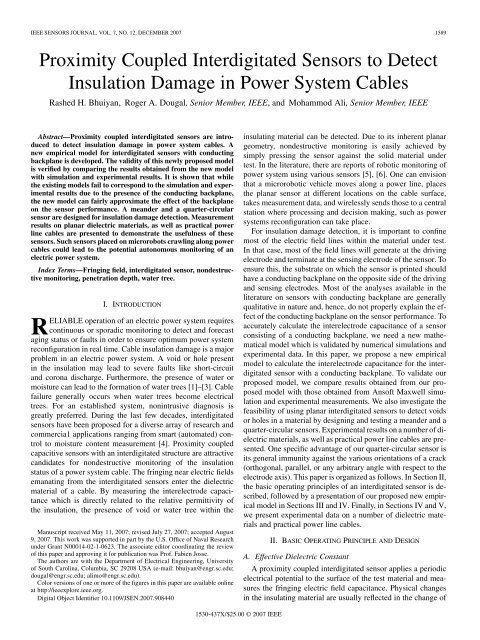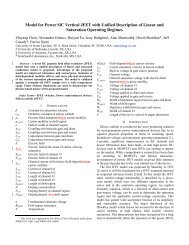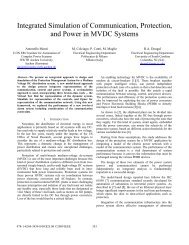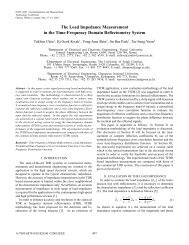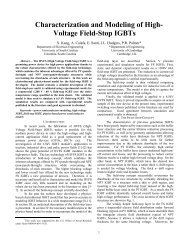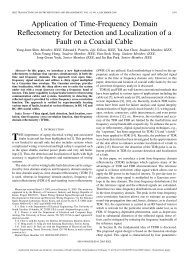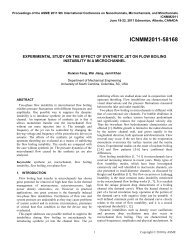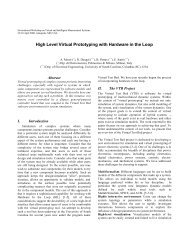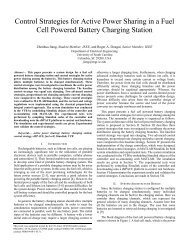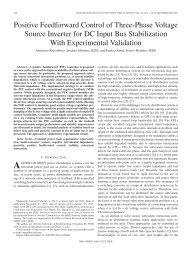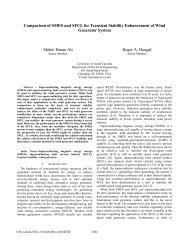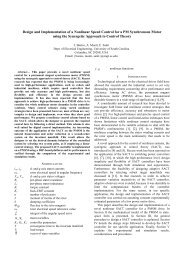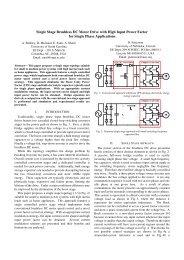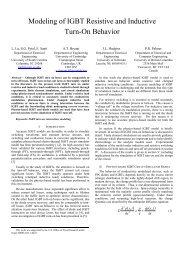Proximity Coupled Interdigitated Sensors to Detect Insulation ...
Proximity Coupled Interdigitated Sensors to Detect Insulation ...
Proximity Coupled Interdigitated Sensors to Detect Insulation ...
You also want an ePaper? Increase the reach of your titles
YUMPU automatically turns print PDFs into web optimized ePapers that Google loves.
1592 IEEE SENSORS JOURNAL, VOL. 7, NO. 12, DECEMBER 2007TABLE IINTERELECTRODE CAPACITANCE DATA OF AN INTERDIGITATED SENSORFig. 7. Estimating A for the sensor with a conducting backplane.field lines of and . As discussed in Section IV-A, canbe calculated aswhere is a constant whose value is estimated based onMaxwell simulations. The <strong>to</strong>tal interelectrode capacitance canbe found by replacing in (6) by in (7).IV. RESULTS(8)A. Empirical Model and Simulation ResultsMaxwell 2-D was used <strong>to</strong> simulate the sensor response. Aunit cell, as shown in Fig. 5, was considered for samples withdielectric constants ranging from 1 <strong>to</strong> 11. However, unlike thestructure in Fig. 5, our simulation model consisted of a conductingbackplane. The simulation results are compared with theresults obtained using our proposed simple model (7). In Fig. 7,the dashed line represents the simulation results, while the solidlines represent results obtained using our proposed equation forvarious values. It is observed that for sample dielectric constantvalues between 1 and 3, the dashed simulation curve is betweenthe empirical curves labeled and .Fordielectric constants ranging from 3 <strong>to</strong> 5, the simulation curve isbetween curves labeled as <strong>to</strong> . Similarly, consideringother regions of the curves and corresponding dielectricconstants, we clearly see that must be at least 0.4 and increaseproportionally with the dielectric constant of the sample whichis estimated in (8).For most practical power line cables, the dielectric constantis low and rarely exceeds 10. For instance, Kynar used as cableinsulation has the highest dielectric constant which is 8.4 at60 Hz [15]. So, it is reasonable <strong>to</strong> choose dielectric constantranging from 1 <strong>to</strong> 10. For this range, an approximate value ofcan be chosen as 0.02. Table I summarizes values of capacitanceper meter for six different samples. It is seen that for asensor without a conducting backplane the capacitance calculatedusing (5) and listed in column 4 agrees well with the simulatedcapacitance listed in column 3. By contrast, for a sensorwith a conducting backplane, the simulation results obtainedFig. 8. Pho<strong>to</strong>graphs of the (a) meander sensor, (b) quarter-circular sensor, and(c) sensor backplane.using Maxwell and listed in column 5 are quite different fromthose listed in column 4. This is due <strong>to</strong> the fact that the modelin (5) does not include the effect of the backplane. In column6 of Table I, we have listed capacitance data calculated usingour proposed empirical model. As apparent from the results, inthe presence of the conducting backplane, our proposed modelis in good agreement with the Maxwell simulation results (incolumn 5).B. Sensor Design for Damage <strong>Detect</strong>ion in MaterialsTo explore the prospects of detecting voids or holes in a dielectricmaterial and also subsequently detect the damage onthe insulation of a power line cable, we designed and fabricatedtwo interdigitated sensors. The pho<strong>to</strong>graphs of the two sensors,the meander and the quarter-circular sensor are shown in Fig. 8.The quarter-circular sensor was designed for rotation insensitivemeasurements, which means due <strong>to</strong> its geometry the measuredinterelectrode capacitance data for a particular sample should begenerally less sensitive when the sensor is rotated on the measurementsample.Each of the above two sensors was used <strong>to</strong> perform measurementson three types of dielectric materials, PTFE, FR4,and Duroid 6010. At first, measurements were done on undam-
BHUIYAN et al.: PROXIMITY COUPLED INTERDIGITATED SENSORS TO DETECT INSULATION DAMAGE IN POWER SYSTEM CABLES 1593Fig. 9. Sample 1.5-mm-thick damaged Duroid 6010.TABLE IIMEASURED CAPACITANCE, C (pF) DATA USING THEMEANDER SENSOR ON UNDAMAGED SAMPLESTABLE IIIMEASURED CAPACITANCE C (pF) DATA FOR QUARTER-CIRCULAR SENSORON UNDAMAGED SAMPLESFig. 10. Comparison of simulated, empirical and measured capacitance for the(a) meander and (b) quarter-circular sensors.aged samples followed by measurements on samples with a12 mm 6 mm hole. Fig. 9 shows the pho<strong>to</strong>graph of a Duroid6010 sample material with a hole. To characterize the materialunder test, the sensor was placed on the sample such that thesensor’s backplane was facing up and the sensor’s <strong>to</strong>p surfacewas in intimate contact with the sample. A 1 kHz sinusoidalsignal was applied as the driving voltage. This low-frequencysignal is easy <strong>to</strong> generate, and it ensured no additional shieldingrequirement, especially from the 60 Hz power line signal. Theamplitude of the 1 kHz signal was chosen <strong>to</strong> be 10 V <strong>to</strong> preventthe opamp from saturation. This also ensured a high enoughoutput signal above the noise level. A 100 pF capaci<strong>to</strong>r was usedas the reference capaci<strong>to</strong>r . This value of gives a measurableoutput voltage, while preventing the opamp from saturating.A piece of 10 mil thick Duroid 5880substratewas used <strong>to</strong> fabricate the sensor. The spatial wavelength, electrode width, height and gap were 4.5 mm, 1.125 mm,17 , and 1.125 mm, respectively.Tables II and III show the interelectrode capacitance,data measured for undamaged samples using the meanderFig. 11.Illustration of (a) orthogonal and (b) parallel damage.and quarter-circular sensors, respectively. Measurements weretaken at three different locations on the sample surface, andthen an average of the data was taken. Simulated, empirical, andmeasured values are compared in Fig. 10. The measureddata are in good agreement with the empirical and simulatedresults.While measuring damaged materials, the orientation of thevoids or holes may be parallel or orthogonal (perpendicular)with respect <strong>to</strong> the electrode axis (see Fig. 11). The cracks/holesmay also form arbitrary angles with respect <strong>to</strong> the electrode axis.In these cases, can vary significantly because the dielectricconstant will depend on the length of the damage whichis traversed by the electric field lines. A circular sensor willbe largely immune <strong>to</strong> this problem because of its geometry.Next, measurements were taken on damaged materials using
1594 IEEE SENSORS JOURNAL, VOL. 7, NO. 12, DECEMBER 2007TABLE IVMEASURED CAPACITANCE C (pF) DATA FOR MEANDER SENSORON DAMAGED SAMPLESTABLE VIMEASURED CAPACITANCE C (pF) DATA FOR PUR CABLETABLE VIIMEASURED CAPACITANCE C (pF) DATA FOR PVC CABLETABLE VMEASURED CAPACITANCE C (pF) DATA FOR QUARTER-CIRCULAR SENSORON DAMAGED SAMPLESthe meander sensor. The sensor surface was rotated with respect<strong>to</strong> the damage and measurements were taken for two extremecases, parallel and orthogonal. These results are shownin Table IV, where we can see that when the axis of damage ina PTFE substrate is parallel with respect <strong>to</strong> the electrode axis,the sensor output is 0.82 pF, whereas when the same damageis orthogonal, the sensor output changes <strong>to</strong> 0.79 pF. Similarlyfor Duroid 6010, the sensor gives 3.85 pF for parallel damageand 3.3 pF for orthogonal damage. It appears that the meandersensor is sensitive <strong>to</strong> the damage orientation particularly for materialswith higher dielectric constants. Measurement data obtainedusing the quarter-circular sensor are listed in Table V.It is observed that the quarter-circular sensor gives 0.99 pF and3.45 pF for PTFE and Duroid 6010 substrates, respectively. Due<strong>to</strong> the finger geometry, there is no parallel or orthogonal orientationof the damage with respect <strong>to</strong> the electrode axis. Measurementstaken by rotating the sensor with respect <strong>to</strong> the damageyielded consistently similar results ensuring that the quarter-circularsensor is insensitive <strong>to</strong> the orientation of the damage.To evaluate the effect of air intrusion in<strong>to</strong> the damaged location,we can compare the data in Table II with those in Table IV.Both of these two data tables represent the meander sensor. Forinstance, for undamaged PTFE, is 1.12 pF as opposed <strong>to</strong>0.82 pF for parallel or 0.79 pF for orthogonal damage. Similarly,for FR4 and Duroid 6010, the values of with no damage are2.2 pF and 5.27 pF, respectively, while those with damage are1.27/1.18 pF and 3.85/3.3 pF, respectively. Clearly, the presenceof a damage decreases the capacitance between the driven andthe sensing electrodes. We observe a very similar trend when wecompare Tables III and V each of which represents measureddata using the quarter-circle sensor. Measured for PTFE,FR4, and Duroid 6010 with no damage are 1.21, 1.83, and 4.51,while those for the same material with damage are 0.99, 1.48,and 3.45, respectively.V. MEASUREMENT OF INSULATION DAMAGEON A POWER LINE CABLEIn our previous discussions, we have developed models andperformed measurements for the interdigitated sensor for testsamples which are planar in nature. However, in practical powersystems if a cable needs <strong>to</strong> be moni<strong>to</strong>red, its surface will be essentiallycurved and the sensor design must be focused in thatdirection so that it can be properly placed on the cable surface.We obtained two types of power line cables from SABNorth America [16]- Polyvinylchloride (PVC) insulated cable( , ) andPolyurethane (PUR) insulated cable ( ,) having dielectric constants of4.0 and 6.0, respectively.To properly place the sensor on one hemicylindrical surfaceof the cable, generally the sensor’s finger length should be small.We designed a sensor with finger length of 10 mm. Then, thesensor was placed on the cable where the driving and sensingelectrodes came in intimate contact with the cable’s surface. Toensure that there was no air gap between the sensor and the cablesurface, a vise was used <strong>to</strong> hold the sensor <strong>to</strong> the cables surface.First, measurements were taken on the cable without anydamage. Then, 12 mm 6 mm holes were created on differentplaces of the cable insulation and a number of measurementswere taken. To measure the presence of materials other than airin the damaged location, a small piece of foam soaked in waterwas also inserted in the hole and measurements were taken.Tables VI and VII list the measurement data for the PUR andPVC cables, respectively. From Table VI, it is observed that thepresence of damage on the PUR cable insulation reduces the capacitanceby 36.7%. The presence of water in the damage,on the other hand, increases significantly (548.9%). Similarly,for the PVC cable, the presence of a damage reducesby 58.5%, while the presence of water in the damage increasesby 537.4%. So, from the sensor output, the existence ofdamage on cable insulation and the presence of air, water, orother materials in the damage can be detected. Even though the
BHUIYAN et al.: PROXIMITY COUPLED INTERDIGITATED SENSORS TO DETECT INSULATION DAMAGE IN POWER SYSTEM CABLES 1595Fig. 12. Illustration of water tree presence in a power line cable.dimensions of the hole/void considered here is relatively largeand, hence, may seem plausible that they can be inspected visually,the proposed technique is advantageous because the alternativeof moni<strong>to</strong>ring visually can be very expensive.Also, as mentioned earlier, another problem commonly encounteredwith aging power line cables is the formation of watertrees due <strong>to</strong> the presence of moisture or water. In cable insulation,tiny channels may grow up in the presence of water. Thesewater filled channels increase rapidly in number and create leaflessbush like structure called water tree, as shown in Fig. 12.The dimension of a water tree varies from a fraction of a millimeter(mm) <strong>to</strong> several mm [1], [17], [18]. To artificially generatean approximate water tree test case, we created 16 adjacentcylindrical holes on the two cables (PUR and PVC). The holeswere 1 mm in diameter and 1 mm in length. Prior <strong>to</strong> measurement,we filled the holes with water. A transparent scotch tapewas placed on <strong>to</strong>p of the holes <strong>to</strong> retain the water. Such test caseswere developed on six different locations for each cable.The bar diagrams in Fig. 13 show the measurement data onthe two cables. It is apparent that there are some variations betweenthe measured data at different locations on the cables.This can be attributed <strong>to</strong> the differences in hole sizes andthe water present in the holes. Nevertheless, in all test cases theis always larger when measurements were taken on <strong>to</strong>p ofwater filled holes.Since sensor response varies at different locations, we proposehere a concept of threshold capacitance level. From thereadings on the PVC cable at six different locations illustrated inFig. 13(a), we see that in the presence of tiny water filled holes,the readings are always above 3 pF, which can be considered asthe threshold level (indicated using the dashed straight line inFig. 13). For PUR cable, the threshold level is 3.5 pF, as seenin Fig. 13(b). The higher value for the PUR cable resultsfrom the higher dielectric constant of the PUR insulation. Thusclearly, the presence of small millimeter sized waterfilled holescan be easily detected using the proposed interdigitated sensors.VI. CONCLUSIONThe potential of a proximity coupled interdigitated sensor forinsulation damage detection in power system cable was studied.A new empirical model <strong>to</strong> analyze a sensor backed by a conductingbackplane was proposed. Results obtained using theFig. 13. Measured capacitance profile of a (a) PVC cable and (b) PUR cablewith waterfilled small holes.proposed model are in very good agreement with the results obtainedfrom Ansoft Maxwell simulation and experimental measurements.A meander and a quarter-circular sensors were designed<strong>to</strong> explore the feasibility of insulation damage detection.It was observed that with both types of sensors, the presence ofa void within a dielectric substrate was easily detectable fromthe measured interelectrode capacitance data. Finally, a sensorwas designed <strong>to</strong> detect the insulation damage of a power linecable. The measurement data confirms that the sensor can indicatethe presence of holes and water trees in a power line cable.Although all measurements were done considering a static platformfor the sensor, we can envision that a microrobotic vehiclemoves along the cable surface, places the sensor and performsthe measurement. However, for voids or water tree damages thatare extremely small (micrometer in dimension and just aboutforming) in size or do not contain enough water or moisture, thechange of dielectric constant at the damaged location may notbe significant enough <strong>to</strong> ensure proper detection. Hence, futureresearch is needed in advanced sensor design that will enableone <strong>to</strong> detect extremely small damaged areas or water trees thatare about <strong>to</strong> form on power line cables.REFERENCES[1] E. F. Steennis and F. H. Kreuger, “Water treeing in polyethylene cables,”IEEE Trans. Electr. Insul., vol. 25, no. 5, pp. 989–1028, Oct.1990.
1596 IEEE SENSORS JOURNAL, VOL. 7, NO. 12, DECEMBER 2007[2] R. Ross, “Inception and propagation mechanisms of water treeing,”IEEE Trans. Dielectr. Electr. Insul., vol. 5, no. 5, pp. 660–680, Oct.1998.[3] T. A. Short, Electric Power Distribution Handbook. Boca Ra<strong>to</strong>n, FL:CRC, 2004, p. 139.[4] A. V. Mamishev, K. Sundara-Rajan, F. Yang, Y. Du, and M. Zahn,“Interdigital sensors and transducers,” Proc. IEEE, vol. 92, no. 5, pp.808–845, May 2004.[5] B. Jiang and A. Mamishev, “Robotic moni<strong>to</strong>ring of power systems,”IEEE Trans. Power Delivery, vol. 19, no. 3, Jul. 2004.[6] B. Jiang, R. M. Wis<strong>to</strong>rt, and A. V. Mamishev, “Au<strong>to</strong>nomous roboticmoni<strong>to</strong>ring of underground cable systems,” in Proc. 12th Inter. Conf.Adv. Robot., Jul. 2005, pp. 673–679.[7] B. C. Wadell, Transmission Line Design Handbook. Norwood, MA:Arctech House, 1991, p. 417.[8] M. Mehregany, P. Nagarkar, S. D. Senturia, and J. H. Lang, “Operationof micro-fabricated harmonic and ordinary side-drive mo<strong>to</strong>rs,” in Proc.IEEE Micro Electro Mecha. Syst. Workshop, 1990, pp. 1–8.[9] N. F. Sheppard, Jr., “Design of a conductimetric microsensor basedon reversibly swelling polymer hydrogels,” in Proc. 6th Int. Conf.Solid-State <strong>Sensors</strong> Actua<strong>to</strong>rs (Transducers’91), San Francisco, CA,Jun. 1991, pp. 773–776.[10] Y. Du, “Measurements and modeling of moisture diffusion processes intransformer,” Ph.D. dissertation, Dept. Elect. Eng. Comput. Sci., Mass.Inst. Technol., Cambridge, MA, 1999.[11] M. C. W. Coln, “A high performance dielectric measurement system,”Ph.D. dissertation, Dept. Elect. Eng. Comput. Sci., Mass. Inst.Technol., Cambridge, MA, 1985.[12] A. V. Mamishev, “Interdigital dielectrometry sensor design andparameter estimation algorithms for non-destructive materials evaluation,”Ph.D. dissertation, Dept. Elect. Eng. Comput. Sci., Mass. Inst.Technol., Cambridge, MA, 1999.[13] R. Y. Scapple, “A trimmable planar capaci<strong>to</strong>r for hybrid applications,”in Proc. 24th Electron. Compo. Conf., 1974, pp. 203–207.[14] E. Endres and S. Drost, “Optimization of the geometry of gas-sensitiveinterdigital capaci<strong>to</strong>rs,” Sens. Actua<strong>to</strong>rs B, Chem., vol. 4, pp. 95–98,1991.[15] C & M Corporation, “<strong>Insulation</strong> materials properties chart.” [Online].Available: http://www.cm-corp.com[16] [Online]. Available: http://www.sabcable.com[17] A. A. Al-Arainy, A. A. Ahaideb, M. I. Qureshi, and N. H. Malik, “Statisticalevaluation of water tree lengths in XLPE cables at differenttemperatures,” IEEE Trans. Dielectr. Electr. Insul., vol. 11, no. 6, pp.995–1006, Dec. 2004.[18] M. Shuvalov, M. Mavrin, V. Ovsienko, and A. Romashkin, “Analysisof water trees in power cable polymeric insulation,” J. App. Poly. Sci.,vol. 88, pp. 1543–1549, 2003.Roger A. Dougal (M’82–SM’94) He received thePh.D. degree from Texas Tech University, Lubbock,in 1983.He joined the University of South Carolina in1983. He is the Thomas Gregory Professor ofElectrical Engineering at the University of SouthCarolina. He is currently Direc<strong>to</strong>r of the Virtual TestBed Project, a multidisciplinary, multiuniversity effort<strong>to</strong> develop a comprehensive design, simulation,and virtual pro<strong>to</strong>typing environment for advancedpower sources and systems, integrating powerelectronics, electromechanics, electrochemistry, and controls in<strong>to</strong> a commontestbed. In addition <strong>to</strong> his interests in modeling and simulation, his expertisealso includes power electronics, physical electronics, and electrochemicalpower sources.Mohammod Ali (M’93–SM’03) received the B.Sc.degree in electrical and electronic engineering fromthe Bangladesh University of Engineering and Technology,Dhaka, in 1987, and the M.A.Sc. and Ph.D.degrees, both in electrical engineering, from the Universityof Vic<strong>to</strong>ria, Vic<strong>to</strong>ria, BC, Canada, in 1994 and1997, respectively.He was with the Bangladesh Institute of Technology,Chittagong, from 1988 <strong>to</strong> 1992. FromJanuary 1998 <strong>to</strong> August 2001, he was with EricssonInc., Research Triangle Park, NC, first as a StaffEngineer and then as a Senior Staff Engineer. Since August 2001, he has beenwith the Department of Electrical Engineering, University of South Carolina,Columbia, where he is currently an Associate Professor. He had also heldappointments as a Visiting Research Scientist with the Mo<strong>to</strong>rola CorporateEME Research Labora<strong>to</strong>ry, Plantation, FL, from June <strong>to</strong> August 2004. He is theauthor/coauthor of over 90 journal and conference publications and holds fiveU.S. patents. His research interests include miniaturized packaged (embedded)antennas, metamaterials and their antenna applications, distributed wirelesssensors and rectennas, reconfigurable antennas, and portable/wearable antennasand their interactions with humans (SAR).Dr. Ali is the recipient of the 2003 National Science Foundation Faculty CareerAward. He is also the recipient of the College of Engineering and InformationTechnology Young Investiga<strong>to</strong>r Award from the University of South Carolinain 2006.Rashed H. Bhuiyan received the B.Sc. and M.Sc. degreesin electrical engineering from the BangladeshUniversity of Engineering and Technology, Dhaka,Bangladesh, in 2003 and 2005, respectively. He iscurrently working <strong>to</strong>wards the Ph.D. degree at theDepartment of Electrical Engineering, University ofSouth Carolina, Columbia, since January 2006.During his B.Sc. and M.Sc. studies, he publishedseveral international conference papers. He alsoserved as a faculty member with the BangladeshUniversity of Engineering and Technology, Dhaka,from 2003 <strong>to</strong> 2005. His current research interests include near-field miniaturesensor design and wireless communications.


